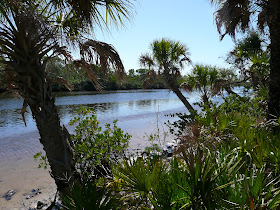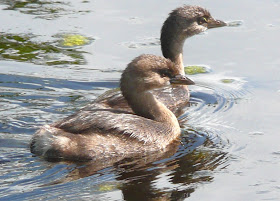A couple of trips to northern Florida/Georgia and a trip up to Illinois in May for a family function helped to the list. My Life List is at 275 plus the 6 non-countables.
- Black-bellied Whistling-Duck
- Fulvous Whistling-Duck
- Snow Goose
- Ross's Goose
- Canada Goose
- Mute Swan
- Muscovy Duck
- Wood Duck
- Gadwell
- Eurasian Wigeon
- American Wigeon
- Mallard
- Mottled Duck
- Blue-winged Teal
- Northern Shoveler
- Northern Pintail
- Green-winged Teal
- Redhead
- Ring-necked Duck
- Lesser Scaup
- Bufflehead
- Common Goldeneye
- Hooded Merganser
- Red-breasted Merganser
- Masked Duck
- Ruddy Duck
- Wild Turkey
- Northern Bobwhite
- Common Loon
- Least Grebe
- Pied-billed Grebe
- Horned Grebe
- American White Pelican
- Brown Pelican
- Double-crested Cormorant
- Anhinga
- Magnificent Frigatebird
- American Bittern
- Great Blue Heron
- Great Egret
- Snowy Egret
- Little Blue Heron
- Tricolored Heron
- Reddish Egret
- Cattle Egret
- Green Heron
- Black-crowned Night-Heron
- Yellow-crowned Night-Heron
- White Ibis
- Scarlet Ibis
- Glossy Ibis
- Roseate Spoonbill
- Wood Stork
- Black Vulture
- Turkey Vulture
- Osprey
- Swallow-tailed Kite
- White-tailed Kite
- Snail Kite
- Bald Eagle
- Northern Harrier
- Sharp-shinned Hawk
- Cooper's Hawk
- Red-shouldered Hawk
- Broad-winged Hawk
- Short-tailed Hawk
- Swainson's Hawk
- Red-tailed Hawk
- Crested Caracara
- American Kestrel
- Merlin
- Peregrine Falcon
- Clapper Rail
- King Rail
- Sora
- Purple Gallinule
- Common Moorhen
- American Coot
- Limpkin
- Sandhill Crane
- Whooping Crane
- Black-bellied Plover
- Snowy Plover
- Wilson's Plover
- Semipalmated Plover
- Piping Plover
- Killdeer
- American Oystercatcher
- Black-necked Stilt
- American Avocet
- Spotted Sandpiper
- Solitary Sandpiper
- Greater Yellowlegs
- Willet
- Lesser Yellowlegs
- Upland Sandpiper
- Whimbrel
- Long-billed Curlew
- Marbled Godwit
- Ruddy Turnstone
- Red Knot
- Sanderling
- Semipalmated Sandpiper
- Western Sandpiper
- Least Sandpiper
- Pectoral Sandpiper
- Purple Sandpiper
- Dunlin
- Stilt Sandpiper
- Ruff
- Short-billed Dowitcher
- Long-billed Dowitcher
- Wilson's Snipe
- Laughing Gull
- Ring-billed Gull
- Herring Gull
- Lesser Black-backed Gull
- Great Black-backed Gull
- Least Tern
- Caspian Tern
- Black Tern
- Common Tern
- Forster's Tern
- Royal Tern
- Sandwich Tern
- Black Skimmer
- Rock Pigeon
- White-crowned Pigeon
- Eurasian Collared-Dove
- White-winged Dove
- Mourning Dove
- Common Ground-Dove
- Monk Parakeet
- Yellow-billed Cuckoo
- Mangrove Cuckoo
- Eastern Screech-Owl
- Great Horned Owl
- Burrowing Owl
- Barred Owl
- Common Nighthawk
- Chuck-will's-widow
- Whip-poor-will
- Chimney Swift
- Ruby-throated Hummingbird
- Belted Kingfisher
- Red-headed Woodpecker
- Red-bellied Woodpecker
- Yellow-bellied Sapsucker
- Downy Woodpecker
- Hairy Woodpecker
- Red-cockaded Woodpecker
- Northern Flicker
- Pileated Woodpecker
- Eastern Wood-Pewee
- Alder Flycatcher
- Least Flycatcher
- Eastern Phoebe
- Say's Phoebe
- Great Crested Flycatcher
- Brown-crested Flycatcher
- Tropical Kingbird
- Western Kingbird
- Eastern Kingbird
- Gray Kingbird
- Scissor-tailed Flycatcher
- Loggerhead Shrike
- White-eyed Vireo
- Bell's Vireo
- Yellow-throated Vireo
- Blue-headed Vireo
- Red-eyed Vireo
- Black-whiskered Vireo
- Blue Jay
- Florida Scrub-Jay
- American Crow
- Fish Crow
- Purple Martin
- Tree Swallow
- Northern Rough-winged Swallow
- Bank Swallow
- Cliff Swallow
- Cave Swallow
- Barn Swallow
- Carolina Chickadee
- Black-capped Chickadee
- Tufted Titmouse
- White-breasted Nuthatch
- Brown-headed Nuthatch
- Carolina Wren
- House Wren
- Ruby-crowned Kinglet
- Blue-gray Gnatcatcher
- Eastern Bluebird
- Veery
- Swainson's Thrush
- Hermit Thrush
- Wood Thrush
- American Robin
- Gray Catbird
- Northern Mockingbird
- Brown Thrasher
- European Starling
- Cedar Waxwing
- Blue-winged Warbler
- Tennessee Warbler
- Nashville Warbler
- Northern Parula
- Yellow Warbler
- Magnolia Warbler
- Cape May Warbler
- Black-throated Blue Warbler
- Yellow-rumped Warbler
- Black-throated Green Warbler
- Yellow-throated Warbler
- Pine Warbler
- Prairie Warbler
- Palm Warbler
- Blackpoll Warbler
- Black-and-white Warbler
- American Redstart
- Prothonotary Warbler
- Worm-eating Warbler
- Ovenbird
- Northern Waterthrush
- Kentucky Warbler
- Common Yellowthroat
- Hooded Warbler
- Summer Tanager
- Scarlet Tanager
- Eastern Towhee
- Bachman's Sparrow
- Chipping Sparrow
- Field Sparrow
- Vesper Sparrow
- Savannah Sparrow
- Grasshopper Sparrow
- Cape Sable Seaside Sparrow
- Song Sparrow
- Swamp Sparrow
- White-throated Sparrow
- Harris's Sparrow
- White-crowned Sparrow
- Northern Cardinal
- Rose-breasted Grosbeak
- Blue Grosbeak
- Indigo Bunting
- Painted Bunting
- Dickcissel
- Bobolink
- Red-winged Blackbird
- Eastern Meadowlark
- Yellow-headed Blackbird
- Common Grackle
- Boat-tailed Grackle
- Shiny Cowbird
- Bronzed Cowbird
- Brown-headed Cowbird
- Orchard Oriole
- Baltimore Oriole
- American Goldfinch
- House Sparrow
- Common Myna
- Egyptian Geese - (non-countable)
- Purple Swamphen - (non-countable)
- Black-Hooded Parakeet - (non-countable)
- Mitred Parakeet - (non-countable)
- Yellow-Chevroned Parakeet - (non-countable)
- Lilac-Crowned Parrot - (non-countable)






















